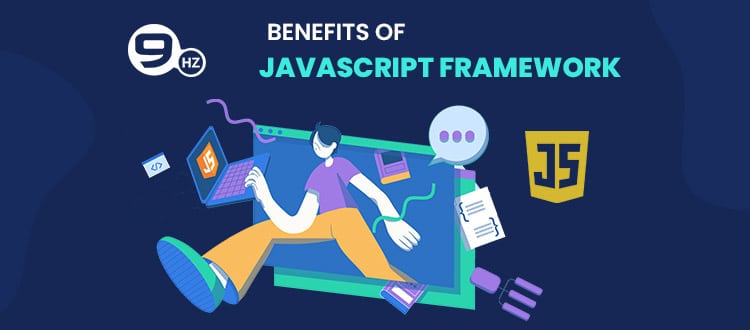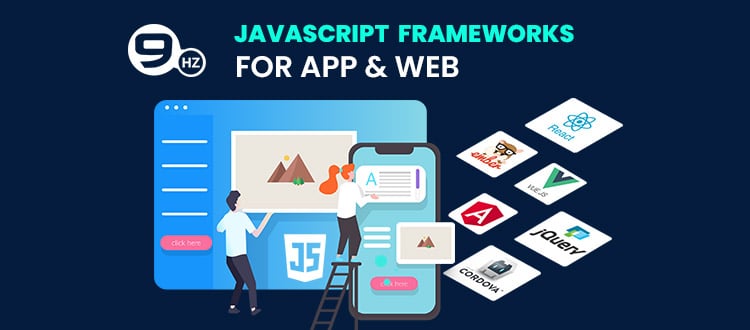Different types of programming languages are used for mobile code applications specific to different operating systems like iOS, Android, and Windows. For instance, while Objective C is used to code an iOS app, Windows uses the .NET framework. An Android app, on the other hand, generally uses JavaScript mobile frameworks. In this blog, we will discuss the top 9 JavaScript frameworks for developing mobile app solutions.
What is JavaScript Framework?
JavaScript is a scripting language undertaken by developers who perform front-end programming applications for building dynamic content and websites or web-based applications. While JS has been the foundation ground, its raw materials were served by JS Frameworks.
JavaScript Framework involves the cost-effective and time-saving means of creating the base codes for crafting out web pages, websites, and web-based applications. It includes libraries in itself; instead of wasting time to create nitty-gritty and long untidy programs, you can easily utilize the ingrained ones. JS Framework metaphorically and practically offers the framework that anchors the codes of the program by shaping them.
Benefits of JavaScript Frameworks for Mobile App Development

The following benefits of JS Framework are:-
- Ingrained HTML Templating: HTML is also a contributor to website and web page creation. Hence, HTML templating will help to point out the appropriately formatted and legitly readable.
- Time and Cost saving: The predetermined codes help in saving your time to craft long, tedious codes and programs.
- Optimized Site Performance: The neat maintenance of web-page models and robust deployment of models with virtual DOM optimizes the site performance of the business.
- Variety: All the frameworks are component-designed based. Therefore, each has a spectacular aspect of admiring, which gives you a variety of ranges to choose from. You can select the framework according to your comfort and expertise.
Difference Between JavaScript Framework and JavaScript Libraries
The long-debated topic certainly now comes down to these differences:-
| JavaScript Framework | JavaScript Library |
|---|---|
| Used for creating websites and web-based applications | Used for JS-based applications and form the base of other codes via its own programs |
| It can create and shape the code and calls the code present in libraries | It consists of predetermined codes that have been assigned by the developer |
| Framework grants control over you | Library grants you control |
| The framework contains a library; it has a wider range of codes | It has limited predefined codes that cannot be altered. |
Also Read: Python Mobile App Development
Difference Between TypeScript vs. JavaScript
| TypeScript | JavaScript |
|---|---|
| It is an object-oriented programming language | It is a scripting language. |
| Static Typing, interface, and modules present | Static Typing, interface, and modules absent |
| Takes more time to compile | Takes less time to compile |
| It points out the commotion of errors erupted in the program or code | It is an interpreted language |
Thus, with some knowledge in JavaScript, you can build amazing mobile applications by using HTML JavaScript mobile frameworks. The availability of versatile JavScript mobile frameworks in the market makes it even easier to build the apps of your dream. But where to start?
To make things a lot more effortless for you, here we have compiled a list of the top 9 JavaScript frameworks for mobile app development!

1. Mobile Angular UI for javascript App Development
Mobile Angular UI is one of the leading JavaScript frameworks for mobile app development and one of the most popular open-source front-end development frameworks that provides all the essential mobile components required in building an app. It packs in an extensive range of features and functionalities, such as switches, overlays, sidebars, navbars, and scrollable areas, to name a few. Primarily used to build dynamic single-page apps (SPA), Mobile Angular UI is used by some of the leading companies and platforms, including LinkedIn, Freelancer, PayPal, and Lego, among many others.
Mobile Angular UI Features
Mobile Angular UI is equipped with an extensive array of features that help in building better applications. Some of the features are:
- The Mobile Angular UI JavaScript framework for web development comes with two-way data-binding capabilities that save a considerable amount of time spent by developers in writing multiple codes and facilitates data synchronization with automatic transfer between the model and view components.
- The framework is packed with HTML templates that are analyzed directly into the DOM.
- It also comes with built-in directives.
- The built-in dependency injection further helps the framework in making the process of application building & evaluation much simpler and effortless.
- The framework has versatile mobile components that include navbars, scrollable areas, accordion, dropdowns, modals, overlays, sections, sidebars, toggle switch, tabs, and several others.
Mobile Angular UI Advantages
Aside from providing a full range of mobile components, one of the most advantageous aspects of Mobile Angular UI is that the Angular-powered applications load pages faster, particularly because Angular leverages browsers to develop pages and prevents additional pressure on the server as a result.
Mobile Angular UI Disadvantages
Debugging apps developed in Mobile Angular UI can be a little more difficult as compared to other JavaScript frameworks. Also, the framework requires server-side authentication and authorization to ensure application security.
Also Read: Top Web Development Frameworks
2. Vue.JS is top JavaScript Framework
Another leading open-source front-end development JavaScript framework is Vue.JS. It uses ‘high decoupling,’ enabling developers to build dynamic user interfaces, and comes with a reactive component system. Although Vue.JS is primarily for HTML JavaScript mobile framework, we can add and use JSX, CSS, and TypeScript as well. Also, it has a special command line (CLI) that allows developers to initiate a new project by simply using a base template. Some of the major users of Vue.JS include Gitlab, Xiaomi, and Alibaba.
Vue.JS Features
The following features make Vue.JS an effective JavaScript framework for web development and help you to build & develop mobile applications with a better flourish:
- Vue.JS leverages virtual DOM that makes it much more flexible for optimization, less expensive, and faster.
- The framework comes with the data-binding feature and a binding directive called v-bind that allows easy manipulation of HTML attributes and facilitates easy change of style, class assigning, and more.
- One of the major features of Vue.JS is its components, through which developers can easily build custom elements and reuse them in HTML.
- Furthermore, it has dedicated features for event handling, animation & transition, templates, routing, CLI, and computed properties, among many others.
Vue.JS Advantages
As an extremely versatile and flexible JavaScript mobile framework, Vue.Js has a wide range of advantages that is quite evident from its growing popularity. It is smaller in size, simple to use, easy to integrate, customizable, and easily optimizable, provides good documentation, has few restrictions, and offers impressive support.
Vue.JS Disadvantages
There are some disadvantages to Vue.JS as well, despite its increasing popularity. For example, the stability of the platform can be questioned, and thus it remains a not-so-recommended option for larger projects where any issues can lead to severe financial losses. Moreover, being still in the development stage, Vue.JS is missing some important plugins.
3. React.JS for javascript Mobile App Development
One of the most famous JavaScript frameworks for mobile app development is React. Launched by Facebook back in 2003, React enjoys a broad community and Facebook Support, accompanied by saturated environments, reusable components, and improved efficiency. Requiring minimum coding efforts, React is considered to be among the best & most efficient frameworks for building fast, responsive, intuitive, and scalable front-end applications. If you are planning to design & build a cross-platform or single-page application (SPA), then React can be your more ideal choice.
React.JS Features
Teact.JS owes its wide popularity and success to its remarkable range of features. These features include the following:
- One of the major features of React.JS is its virtual DOM that makes application development faster, more efficient, and more flexible.
- Another chief feature of ReactJS is that it uses JSX, which renders writing code and the step-by-step development of an application more effortless & simple.
- React.JS has the one-way data flow capability, preventing developers from editing any component without the callback function and allowing them to gain better control over the development process.
- React.JS uses a custom rendering called React Native that uses native components in place of web components.
- Furthermore, React.JS possesses a component-based architecture and helps in building apps with an interactive user interface.
React.JS Advantages
Packed with amazing features, React.JS is definitely one of the most advantageous JavaScript mobile frameworks available today. It is lightweight and is perfect for large-scale projects with its efficiency and speed. Additionally, React.JS offers a modular structure that is incredibly flexible and focuses on delivering high application performance. Its rich toolset, reusable components, strong support backup, SEO-friendly navigation, and user-friendly approach makes it a favorite of the global developer community.
React.JS Disadvantages
Like most other JavaScript frameworks for web development, React.JS isn’t perfect as well. In fact, its pace of development can act as a disadvantage too. The fast-changing environment of the framework makes it hard for some developers to adapt to it simultaneously. Not only that, the framework lacks proper documentation capabilities, which can be a result of its constantly updating technologies. Also, React.JS only covers the UI layer of an application, thus demanding other technologies for project completion.
4. Node.JS A Popular Javascript Frameworks
Node.js is a free, open-source, server-side framework that is primarily used for building server-side applications. This JavaScript mobile framework can run on different platforms, including Windows, Linux, Unix, Mac, and OS X. Node.JS is built on the JavaScript engine, called the V8 engine, of Google Chrome and was first launched in 2009. Node.js has a rich library of JavaScript modules and a powerful runtime environment, both enabling application development in a more simplified way. It has a rapidly growing user base and includes famous platforms like Netflix, Walmart and Uber, among many others.
Node.JS Framework Features
The versatile features of this JavaScript framework are the reasons why Node.JS is a highly preferred framework. These features include the following:
- Node.JS is known for its exceptional speed in the execution of codes, a characteristic that can be attributed to its V8 JavaScript engine.
- The asynchronous or non-blocking APIs of Node.JS make the framework characteristically event-driven.
- Node.JS possesses a single-threaded program that facilitates event looping.
- Node. JS has high scalability.
- Data buffering is absent in Node.JS, and as a result, applications output data in fragments.
- Node.JS operates under the MIT license.
Node.JS Advantages
One of the major pros of Node.JS is that it can multitask like few others. Its enhanced ability to multitask is accompanied by the benefit of advancements that are brought about by Google Chrome’s V8 benchmark suite. The framework offers improved performance, easy adaptability & scalability, community support, and a cost-effective solution. It also helps in increasing app response time, decreases loading time and time to market, and assists in developing cross-platform applications.
Node.JS Disadvantages
Node.JS has some cons as well, and they can create some serious issues. For example, the framework is not perfectly capable of executing heavy computing tasks and reduces performance in its efforts. Lack of library support and the instability of APIs are other drawbacks of this JavaScript mobile framework.
Also Read: AngularJS Vs ReactJS
5. PhoneGap is One of the Most Popular Javascript Framework
PhoneGap is a software development framework that enables developers to build mobile applications with only the knowledge of web development languages. To put it more simply, the framework does not demand knowledge of mobile programming language and helps in developing apps with HTML, CSS, and JavaScript. As an HTML JavaScript mobile framework, PhoneGap delivers apps for almost all types of operating systems, including Android, iOS, BlackBerry, Windows, and so on.
PhoneGap Framework Features
- One of the major characteristic features of PhoneGap is that it uses multiple languages, including HTML, JavaScript, and CSS.
- Another feature of PhoneGap is that it can expand its functionalities by extending its scope with native plugins.
- The easy flexibility of the framework is a chief feature of Phonegap.
- It has a robust back-end system designed to minimize development efforts with high-speed execution.
PhoneGap Framework Advantages
A major benefit of using PhoneGap is that it can build a single application and distribute it across various mobile operating systems. Not only that, the framework ensures consistent delivery across all platforms. Moreover, the powerful back-end, accompanied by easy-to-use plugins, significantly adds to its many advantages.
PhoneGap Framework Disadvantages
Even though PhoneGap has certain disadvantages, they are limited in number. Most importantly, the framework doesn’t support plugins with hooks. Other than that, PhoneGap isn’t designed as a JavaScript mobile game framework and hence cannot develop hardware-intensive applications. Also, a Mac is required to build an application for iOS with PhoneGap.
6. jQuery Mobile
jQuery is a cross-platform, lightweight JavaScript mobile framework that abides by its “write less, do more” approach. It is independent of any platform and can be used across different types of browsers. It not only simplifies the scripting of HTML but also makes processes like event handling, Ajax, animation, etc., extremely simple. If you are looking forward to making your new application both attractive and interactive, then jQuery can be an incredible choice. jQuery is used by some leading companies, which include Twitter, Uber, Angellist, Hootsuite, and Kickstarter.
jQuery Mobile Features
Simple and easy to learn, jQuery is packed with loads of features that make it more efficient. The wide range of features include the following:
- jQuery comes with a predefined method through which you can perform any task you want, making the framework simple and easy.
- It is small and lightweight.
- It has a predefined CSS manipulation approach.
- HTM manipulation is also easy thanks to features like easy modification of DOM elements.
- Its cross-browser support is an extremely important feature of the HTML JavaScript mobile framework.
- Another critical feature of jQuery is its AJAX support that allows developers to build a responsive application.
- Built-in animation of the framework is a great feature that enables the easy creation of custom animations.
jQuery Mobile Advantages
A great advantage of using jQuery as your JavaScript mobile framework is that it readily supports a number of operating platforms, both modern and old. Its flexibility across browsers also adds to its pros, which are further enhanced by its easy event handling, DOM-specific tools, AJAX implementation, and dynamic effects creation capabilities.
jQuery Mobile Disadvantages
One of the major disadvantages of jQuery is that it has a huge library to import that can slow down the development process. Moreover, the DOM APIs of jQuery are obsolete, and the abstraction of the frameworks makes learning JavaScript a much more difficult effort.
7. Sencha Touch is One of the Famous Javascript Frameworks
Sencha Touch is a leading HTML JavaScript framework for mobile app development that is based on the MVC architecture. It is popularly considered as the only JavaSCript framework that provides optimal tools to developers, particularly focused on building dynamic mobile applications for various operating systems, including Android, BlackBerry, iOS, and Windows. Developers can build apps simply using HTML, JavaScript, and CSS with the Sencha Touch. Equipped with creative components, the framework is well packed in amazing features & tools.
Sencha Touch Features
The most prominent features of the Sencha Touch HTML JavaScript mobile framework are as follows:
- It comes with more than 50 built-in UI widgets that are easily customizable and includes rich functionalities like carousels, menus, lists, toolbars, and forms.
- Native looking themes are characteristics of the Sencha Touch framework.
- This JavaScript mobile framework offers code compatibility across new and old versions.
- It packs in features like adaptive layouts, easy scrolling, and animations for a better user experience.
- Another feature of the framework is its flexible layout manager.
Sencha Touch Advantages
As a standard Javascript framework, Sencha Touch offers lots of benefits for developers. For instance, the responsive interface facilitates seamless navigation and enhanced speed. It also offers a cost-effective solution as far as cross-platform compatible mobile frameworks go.
Sencha Touch Disadvantages
Sencha Touch has certain limitations as well. Such as, the apps developed with this JavaScript mobile framework don’t have the capability to access device-specific functions like contacts, camera, etc., it can’t send push notifications, and it isn’t appropriate for hardcore graphics. As a result, Sencha Touch isn’t a good JavaScript mobile game framework.
8. Meteor
Another robust and advanced JavaScript mobile app framework is Meteor. A full-stack JavaScript framework, it is particularly designed to maximize the capabilities of Node.JS and to develop real-time applications. It is well equipped with essential features & tools most demanded by modern developers and helps you to build interactive mobile applications. With good documentation as well as adequate learning resources, Meteor is basically everything a developer might need to build superior quality mobile applications.
Meteor Features
Meteor is packed with striking features, specifically designed to fulfill all the requirements of developers. The most prominent features include:
- The topmost characteristic feature of Meteor is that it is a full-stack solution, equipped with advanced built-in features like automatic CSS, reactive templates, and more.
- Its capability to build real-time applications from scratch is another feature of the framework.
- Meteor possesses both front-end and back-end components, including libraries, databases, and so on.
- One of the major features of the framework is its isomorphic coding abilities.
- The built-in custom package manager adds to the list of Meteor’s advanced features.
Meteor Advantages
Meteor’s advantages go far beyond its robustness and full-stack capabilities. It is easy to learn, is incredibly responsive in nature, and is highly focused on user experience. Furthermore, Meteor allows code reuse and has a powerful CLI that empowers its environment.
Meteor Disadvantages
Despite its advantages, Meteor has its own weaknesses and limitations. For example, the Javascript mobile framework particularly lacks strong computing power. Not only that, being new in the field, Meteor doesn’t possess equal efficiency in large-scale application deployments.
9. NativeScript
NativeScript is yet another cross-platform JavaScript mobile app framework designed to enable developers to build applications for Android and iOS platforms. It primarily uses JavaScript but also allows TypeScript utilization. The latest version of Native Script, NativeScript 6.0, was launched recently and is well-equipped with advanced features designed to escalate the capabilities & performance.
NativeScript Features
The latest version NativeScript 6.0, has the following prominent features:
- One of the major features in this new version of the JavaScript mobile framework is the bundle workflow, through which developers can bundle source codes more effectively.
- The latest update enables fast-paced development.
- The new version provides AndroidX support.
- One of the most valuable additions to the new version is the TabView that provides developers with enhanced flexibility and customization options.
NativeScript Advantages
NativeScript is extremely advantageous if you are looking for an advanced framework that executes exceptionally faster. Moreover, it helps to build truly native apps and uses native components, significantly boosting overall performance.
NativeScript Disadvantages
One of the major limitations of NativeScript is its instability that accompanies frequent updates. Also, the documentation isn’t up to the mark, especially if compared to other cross-platform JavaScript mobile frameworks.
Conclusion:JavaScript Frameworks for Mobile App Development
Now that you have learned about the top JavaScript mobile frameworks, it will be much easier for you to choose the right one for your next project. However, it is important to remember that choosing a framework for its features alone may not always seem fruitful. Hence, you have to stay focused on the overall functionality of the framework and efficiency while at the same time ensuring that it meets your unique requirements.
FAQs On JavaScript Frameworks for Web Development
Q.1 What is a JavaScript Framework?
JavaScript frameworks are those applications that programmers can utilize in order to deploy manipulation tactics over certain functions. Therefore, Javascript Frameworks are quite agile and adaptable.
Q.2 What are the Most Popular JavaScript Frameworks?
Top JS Frameworks include all the aforementioned frameworks that have been well-elucidated, like React, Angular, Vue, Node, Snecha touch, etc. These frameworks are involved in the creation of websites and web-based applications.
Q.3 Which JavaScript Frameworks are the fastest?
React, Vue, and Angular fall under the category of being the fastest JS Frameworks because of their fast mounting technology utilized with excellence as well as supported by a seamlessly smooth UI.
Q.4 Which is the Easiest JavaScript Framework to Learn?
As a front-end framework of JS, Vue.JS is the easiest to learn amongst all the JS frameworks present, provided that developers can deploy writing SPA without worrying over the consequential impact in bulk.
Great Together!









